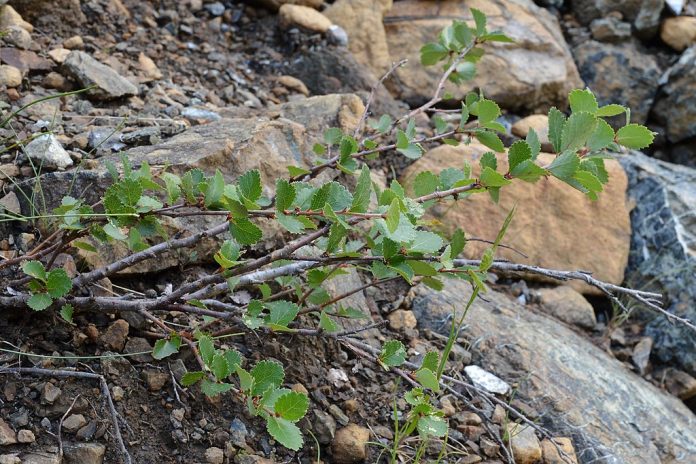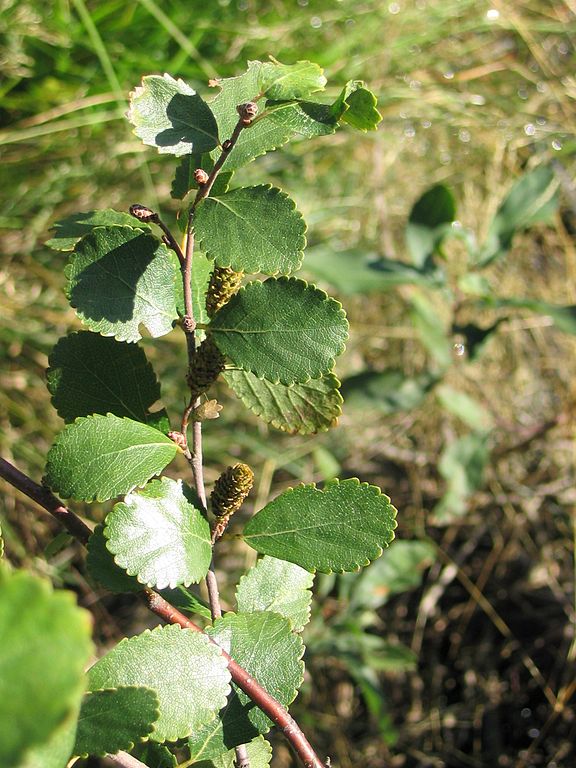
Photo by Ryan Hodnett / CC BY-SA 4.0
A field guide on how to identify and propagate Bog Birch (Betula pumila), a hardy shrub that is native to Northern Canada & Alaska.
How to Identify Bog Birch (Betula pumila)
Leaves & Flowers

Bog birch produces glossy, oval-shaped leaves with serrated margins. They grow on the stems in alternate arrangements.
These little shrubs also produce yellowish-green catkins, which are flower clusters that hang from branches.
These catkins symbolize the arrival of spring and the production of seeds and eventually develop into small, winged seeds that are dispersed by the wind.
Flowering Season
Bog birch’s flowering season typically occurs in late spring to early summer. The exact timing can vary depending on the specific location and climate conditions.
Habitat
The typical habitat of bog birch (Betula pumila) is in wet, acidic areas such as bogs, fens, and swamps. It is generally found in cold regions, including subarctic and alpine environments, where it can withstand harsh conditions and low temperatures.
Some other understory plants that associate with bog birch are:
- Bog rosemary (Andromeda polifolia)
- Labrador tea (Rhododendron groenlandicum)
- Bog cranberry (Vaccinium oxycocos)
- Bog cotton (Eriophorum spp.)
Wildlife Value
Bog birch is highly valuable for wildlife, providing habitat and food sources for various species.
Birds, especially songbirds and waterfowl, use it for nesting and feeding on its seeds. Insects like butterflies and bees are attracted to its flowers for nectar.
Small mammals such as rabbits and rodents find shelter and food in the shrub. Its dense foliage and ability to thrive in wetlands make it crucial for wildlife ecosystems.
How to Propagate Bog Birch (Betula pumila)

Hardiness Zone: 2-6

Soil Type: Peat, loam, clay.

Water: Normal to High.

Exposure: Full Sun
The best way to propagate bog birch is by sowing the seeds.
Their seeds can be collected in large quantities, require minimal equipment for sowing, and have a higher success rate compared to other methods like vegetative propagation.
Personally, I have had no luck propagating any kind of birch by using cuttings, while seeds have always worked flawlessly.
How to Propagate Bog Birch (Betula pumila) by Seed
If you’ve identified some specimens yourself, then all you need to do next is to go out and collect their seeds. The best time for seed harvest is later in the summer when the catkins have matured.

I would say typically from mid-August until the end of fall. Although their seeds even persist past snowfall and would be collectible during winter.
How to Harvest Seeds
To collect bog birch seeds, what I do is pull on the catkins while holding a bag underneath. This way I can separate the seeds from the stem and just let them fall into my bag.
Sowing
Most birch species can germinate just fine without any seed treatment, it’s great! What they need is simple: light and water.
To get them started, surface sow your seeds in a mix of peat and sand, water well, and then place them in a well-lit area. Generally, you’ll see the first sprouts within a week.
FAQ
A: They typically reach a height of 3 to 10 feet (0.9 to 3 meters) at maturity. However, it can occasionally grow up to 20 feet (6 meters) under ideal conditions.
A: The twigs and leaves of the Bog Birch can be used to make herbal teas, which have a mild, pleasant taste. Some people also use the young leaves as a salad green or in cooking as a flavoring agent
A: White-tailed deer and prairie chickens are known to browse the foliage and catkins.
